Sym and aysm at once............just like the beg of the primes..........2, 3, 5, 7.............2 and 3..............are the only two primes..........EVER..........to be one digit apart................99%.............different...........the 3rd is different..........just like 20 - 30 is different............in terms of the number of primes in that series....................a 15 year old or so F Gauss saw a pattern in the distribution of primes..............factored by 2..............every even neg number...................on the X axis...........all even numbers..........can be factored by 2.......................like 2pi............full circle...
Why else 40 - 60?? 4 and 6.............the 1st two non primes........discounting 0 and 1.........b/c of their spec imp.........I think from some perspectives it IS imp to include them........but for simplicity's sake..............................6.28..................2pi...........the 1st 3 digits of it.........one number above the dec................2 numbers below it.............28/6 = 4.666..........like F's 1st c.............28 - 6 = 22..................2 twos..............2 and 2 - 11............................two prime fund...........there may be more..................
Normal Distribution
Data can be "distributed" (spread out) in different ways.| It can be spread out more on the left | Or more on the right | |
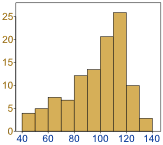 | 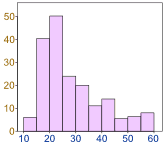 | |
| Or it can be all jumbled up |
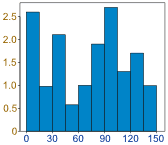 |

A Normal Distribution
The "Bell Curve" is a Normal Distribution.
And the yellow histogram shows some data that
follows it closely, but not perfectly (which is usual).
And the yellow histogram shows some data that
follows it closely, but not perfectly (which is usual).
 | It is often called a "Bell Curve" because it looks like a bell. |
- heights of people
- size of things produced by machines
- errors in measurements
- blood pressure
- marks on a test

Quincunx
| You can see a normal distribution being created by random chance! It is called the Quincunx and it is an amazing machine. Have a play with it! | 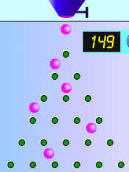 |
Standard Deviations
The Standard Deviation is a measure of how spread out numbers are (read that page for details on how to calculate it).When we calculate the standard deviation we find that (generally):
 | 68% of values are within 1 standard deviation of the mean 95% of values are within 2 standard deviations of the mean 99.7% of values are within 3 standard deviations of the mean |
Example: 95% of students at school are between 1.1m and 1.7m tall.
Assuming this data is normally distributed can you calculate the mean and standard deviation?The mean is halfway between 1.1m and 1.7m:
Mean = (1.1m + 1.7m) / 2 = 1.4m
95% is 2 standard deviations either side of the mean (a total of 4 standard deviations) so:| 1 standard deviation | = (1.7m-1.1m) / 4 |
| = 0.6m / 4 | |
| = 0.15m |
And this is the result:
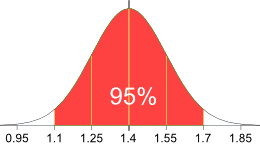

No comments:
Post a Comment